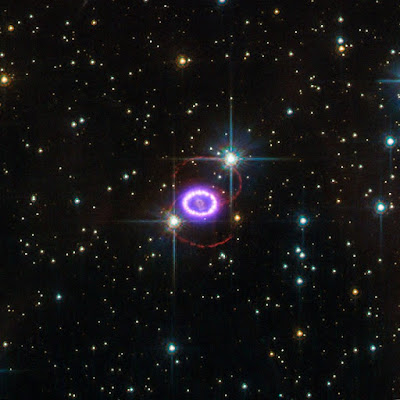- 4172 - SUPERNOVA - we catch an explosion early? A large fireball star emanates a sphere of fiery expulsion. It is a massive star in the final year of its life. It ejected large amounts of matter into space before going supernova.
---------------- 4172 - SUPERNOVA - we catch an explosion early?
- A large fireball
star emanates a sphere of fiery expulsion.
It is a massive star in the final year of its life. It ejected large amounts of matter into space
before going -supernova.
-
- The massive star
exploded in the Pinwheel Galaxy in May, 2023.
It appears to have unexpectedly lost approximately one sun's worth of
ejected mass during the final years of its life before going supernova.
-
- Amateur
astronomers have a long history of discovering exploding stars before the
professionals spot them. Amateur
astronomers around the world started gazing at “SN 2023ixf” because the Pinwheel in general is a popular
galaxy to observe.
-
- Haste is key when it comes to supernova observations. Astronomers want to understand exactly what
is happening in the moments immediately after a star goes supernova. Yet all
too often, a supernova is spotted several days after the explosion took place,
so they don’t get to see its earliest stages.
-
- Astronomers measured the supernova's light
spectrum, and how that light changed over the coming days and weeks. When
plotted on a graph, this kind of data forms a "light curve."
-
- The spectrum from
“SN 2023ixf “showed that it was a type II supernova, which is a category of
supernova explosion involving a star with more than eight times the mass of the
sun.
-
- The spectrum was
also very red, indicating the presence of lots of dust near the supernova that
absorbed bluer wavelengths but let redder wavelengths pass. This was all fairly
typical, but what was especially extraordinary was the shape of the light
curve.
-
- Normally, a type II
supernova experiences what astronomers call a 'shock breakout' very early in
the supernova's evolution, as the blast wave expands outwards from the interior
of the star and breaks through the star's surface. Yet a bump in the light
curve from the usual flash of light stemming from this shock breakout was
missing. It didn’t turn up for several
days. Was this a supernova in slow motion, or was something else happening?
-
- The delayed shock
breakout is direct evidence for the presence of dense material from recent mass
loss. Observations revealed a
significant and unexpected amount of mass loss, close to the mass of the sun,
in the final year prior to explosion.
-
- This unstable star
was puffing off huge amounts of material from its surface. This creates a dusty
cloud of ejected stellar material all around the doomed star. The supernova
shock wave therefore not only has to break out through the star, blowing it
apart, but also has to pass through all this ejected material before it becomes
visible.
-
- Massive stars
often shed mass. Betelgeuse’s star over
late 2019 and early 2020 has belched out a cloud of matter with ten times the
mass of Earth’s moon that blocked some of Betelgeuse’s light, causing it to
appear dim. However, Betelgeuse isn’t ready to go supernova just yet, and by
the time it does, the ejected cloud will have moved far enough away from the
star for the shock breakout to be immediately visible.
-
- In the case of “SN
2023ixf”, the ejected material was still very close to the star, meaning that
it had only recently been ejected, and astronomers were not expecting that.
-
- Using both optical
and millimeter telescopes astronomers effectively turned SN2023ixf into a time
machine to reconstruct what its progenitor star was doing up to the moment of
its death.
-
- Stars are just
like onions. We can think of an evolved massive
star as being like an onion, with different layers. Each layer is made from a
different element, produced by sequential nuclear burning in the star's
respective layers as the stellar object ages and its core contracts and grows
hotter.
-
- The outermost
layer is hydrogen, then to helium. Then through carbon, oxygen, neon and
magnesium in succession until you reach all the way to silicon in the core.
That silicon is able to undergo nuclear fusion reactions to form iron, and this
is where nuclear fusion in a massive star’s core stops because iron requires
more energy to be put into the reaction than comes out of it, which is not
efficient for the star.
-
- Thus the core
switches off, the star collapses onto it and then rebounds and explodes outwards.
-
- One possibility is
that the final stages of burning high-mass elements inside the star, such as
silicon (which is used up in the space of about a day), is disruptive, causing
pulses of energy that shudder through the star and lift material off its
surface.
-
-
September 29, 2023 SUPERNOVA - we
catch an explosion early? 4172
------------------------------------------------------------------------------------------
-------- Comments
appreciated and Pass it on to whomever is interested. ---
--- Some reviews are
at: -------------- http://jdetrick.blogspot.com -----
-- email feedback,
corrections, request for copies or Index of all reviews
--- to: ------
jamesdetrick@comcast.net
------ “Jim Detrick” -----------
--------------------- ---
Monday, October 2, 2023 ---------------------------------

No comments:
Post a Comment